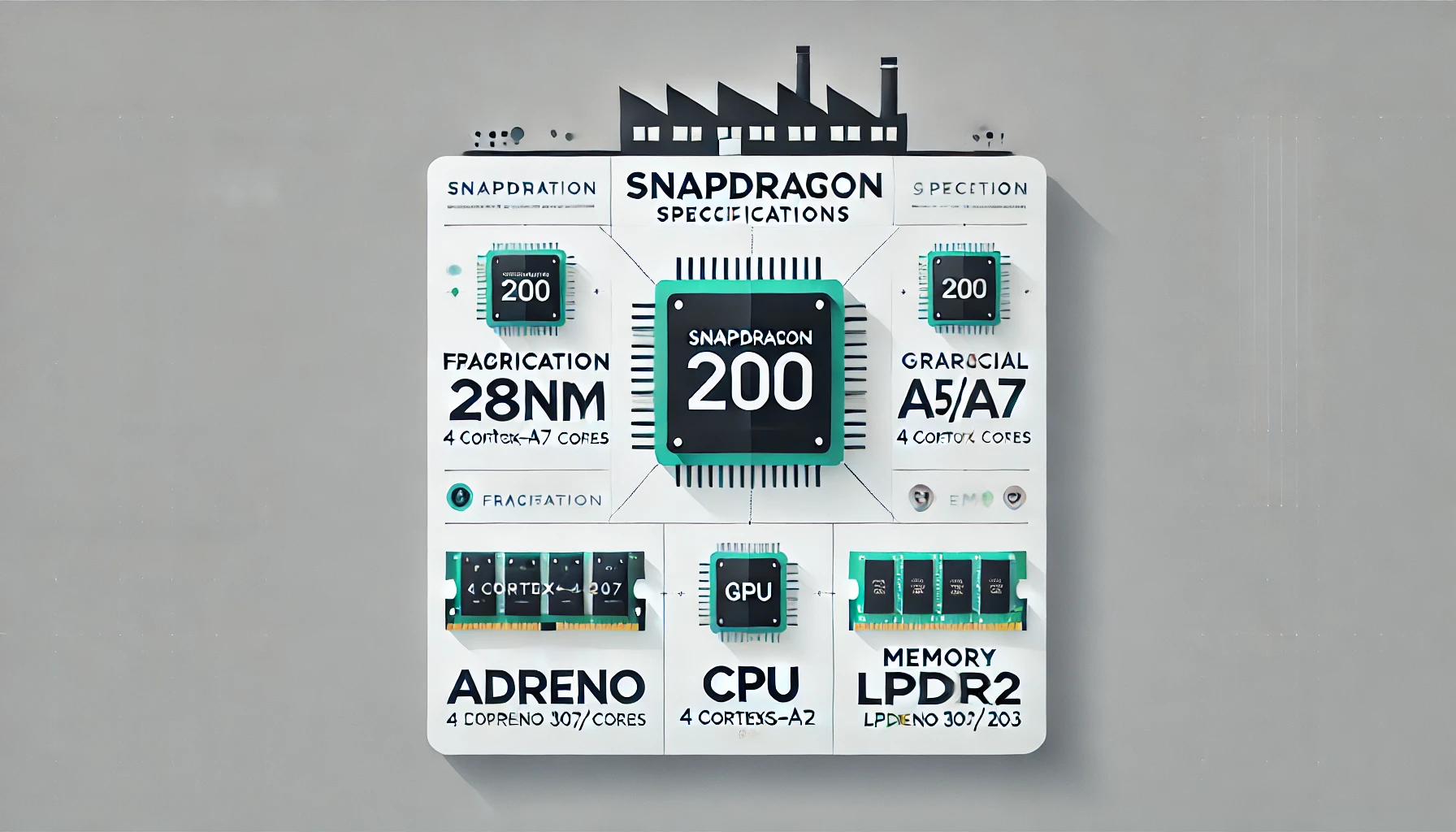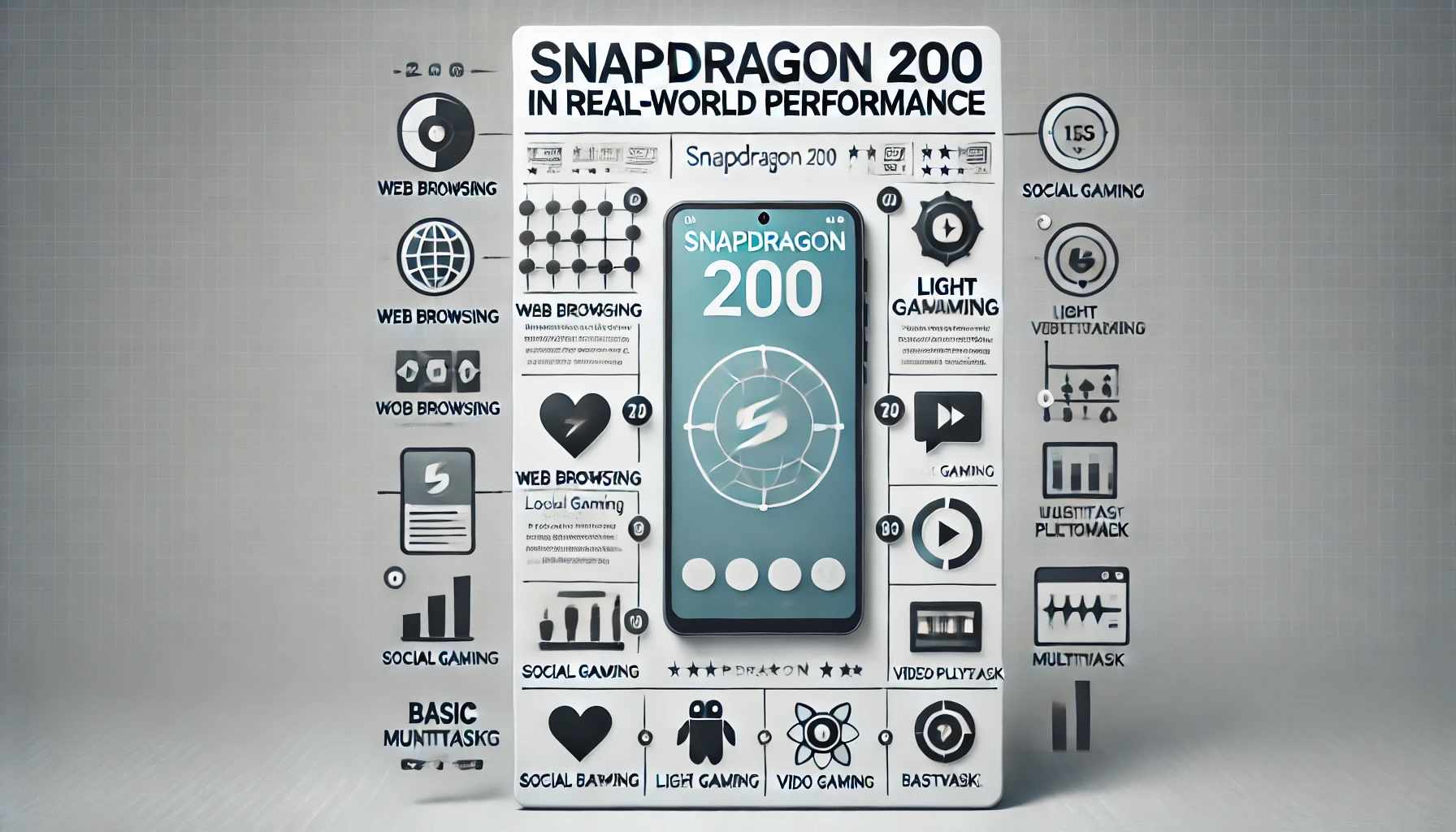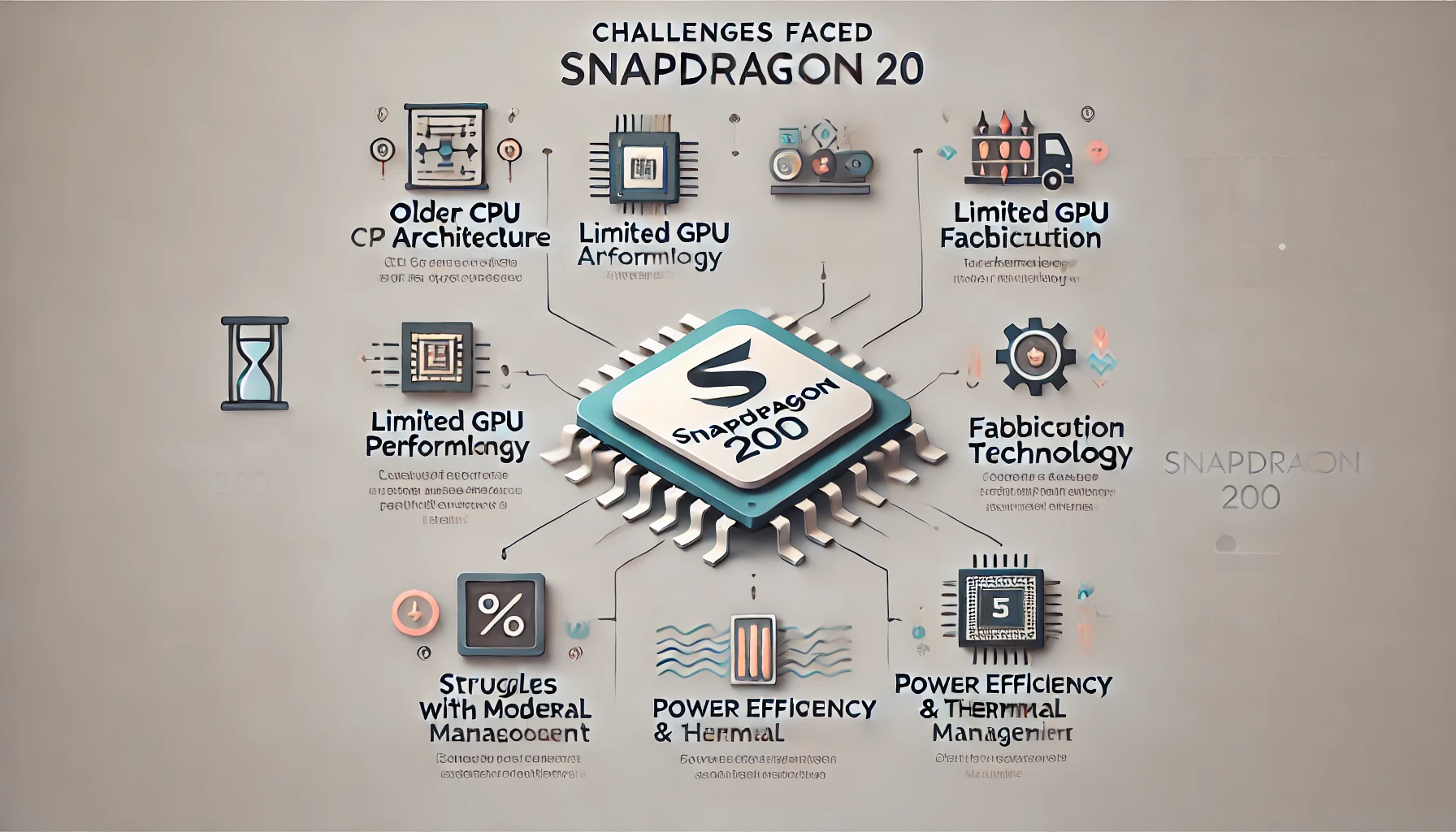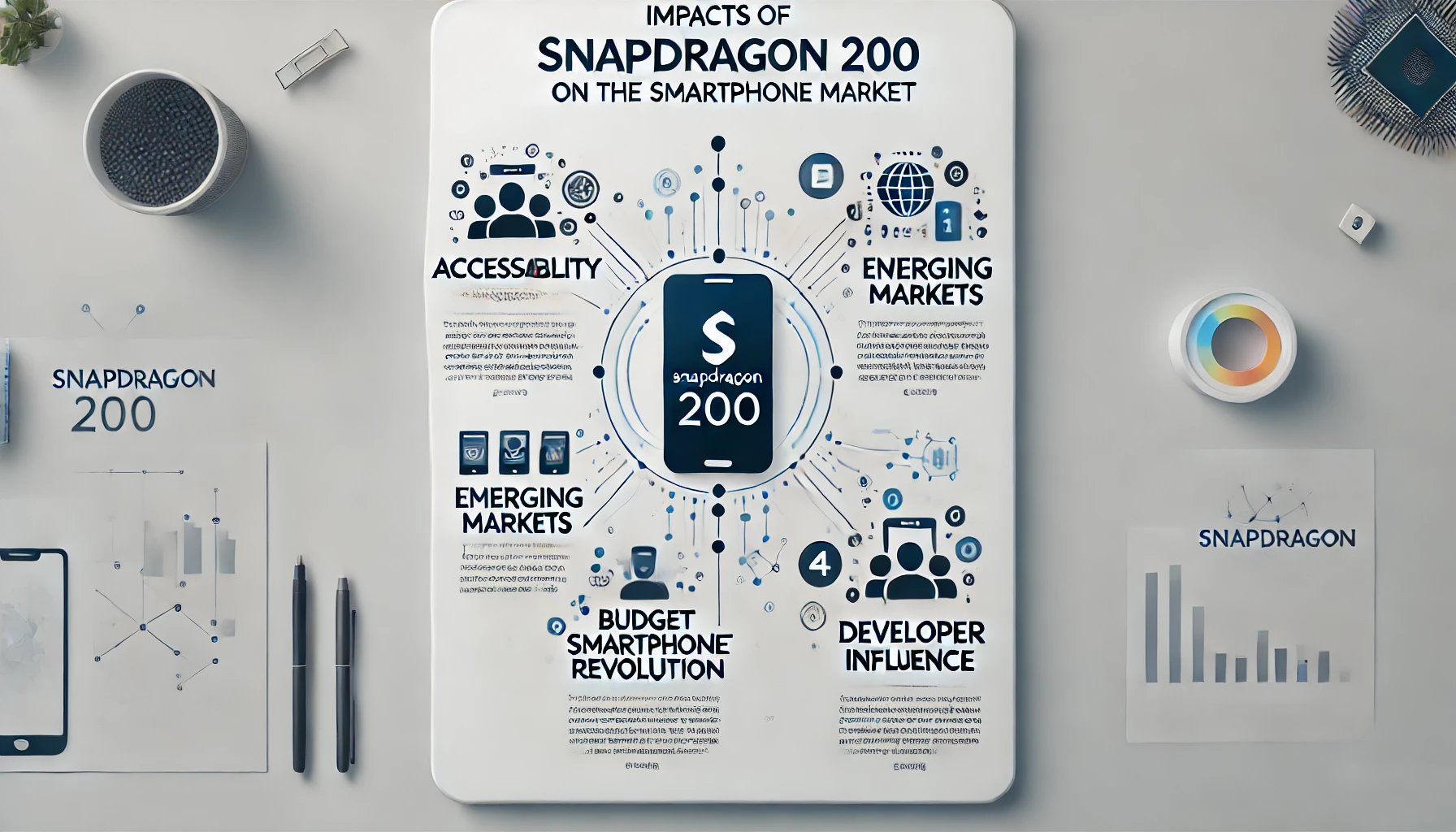Qualcomm’s Snapdragon series has long been at the forefront of mobile processing, powering everything from flagship devices to entry-level smartphones. The Snapdragon 200, introduced as an affordable SoC (System on Chip), was designed to cater to the budget-conscious segment of the market. It aimed to provide basic smartphone functionality at a cost-effective price, targeting users in emerging markets and those seeking affordable devices.
Snapdragon 200 Specifications
Fabrication
The Snapdragon 200 was produced using 45nm and 28nm fabrication processes, offering improved performance and power efficiency. These processes directly impact how much energy the SoC consumes and how well it performs, particularly when multitasking or handling background processes. The shift from 45nm to 28nm technology improved smartphone efficiency for entry-level devices.
CPU
The Snapdragon 200 comes in two variants, one with 4x Cortex-A5 cores clocked at 1.4 GHz and another with 4x Cortex-A7 cores clocked at 1.2 GHz. These cores are designed to handle basic tasks such as browsing, messaging, and running light applications. While not powerful by today’s standards, they provide sufficient processing power for users of budget smartphones.
GPU
The GPU options include the Adreno 302 and Adreno 203, both of which support 720p displays. Though not optimized for high-end gaming, these GPUs provide basic graphical performance for entry-level devices, making it possible to enjoy casual games and media playback on a budget.
Memory
Snapdragon 200 supports Single-Channel LPDDR2 memory. This memory configuration allows for basic multitasking, but its limitations may make it unsuitable for more intensive applications. This was a common trade-off for affordable smartphones using the Snapdragon 200.
Fast Charging
Qualcomm introduced Quick Charge 2.0 with the Snapdragon 200, bringing faster charging to budget smartphones. This feature was a significant step forward for users who previously had to deal with slow charging times, making the smartphone experience more convenient even on entry-level devices.
Snapdragon 200 in Real-World Performance
The Snapdragon 200 is suitable for basic applications, web browsing, and light gaming in day-to-day use. However, it needs help with more demanding apps in modern contexts, especially those with high processing or graphical requirements. Compared to newer entry-level SoCs, the Snapdragon 200 must improve performance, but it remains a viable solution for basic smartphone users.
List of Phones Powered by Snapdragon 200
Many budget smartphones utilized the Snapdragon 200. Here are some notable models:
- HTC: Desire 316, Desire 516, Desire 500, Desire 600
- Motorola: Moto E
- Nokia: Lumia 530, Lumia 535
- Karbonn: Titanium S1 Plus, Titanium S5
- Sony: Xperia E1, E1 Dual
- LG: L70, L40
- Micromax: A111 Canvas Doodle
- Panasonic: T11
- Samsung: Galaxy Win
These devices brought basic smartphone functionality to users worldwide at an affordable price.
Challenges Faced by Snapdragon 200
As the mobile industry advanced, the Snapdragon 200 encountered significant challenges in keeping up with the growing demands of modern applications and user expectations. Several factors contributed to these limitations, primarily related to the SoC’s ageing architecture, GPU performance, and fabrication technology. Here’s a closer look at the challenges faced by Snapdragon 200:
Older CPU Architecture
The Snapdragon 200’s CPU options, the Cortex-A5 and Cortex-A7, were designed for entry-level performance. While adequate for basic tasks such as web browsing, messaging, and running simple apps, these CPUs quickly showed their age as applications became more demanding. Modern apps require higher processing power for multitasking, advanced features, and media-rich content, which the Snapdragon 200 struggled to deliver.
- Single-Core Performance: With more apps optimized for multi-core processors and relying heavily on single-core performance, the Snapdragon 200’s Cortex-A5 and A7 cores couldn’t keep up with the requirements of modern operating systems and apps. Performance lags became common when running apps requiring more processing power.
- Lack of Advanced Features: The older architecture also needed modern CPU features such as faster processing speeds, energy efficiency enhancements, and support for emerging technologies like machine learning and AI integration, which newer SoCs offered.
Limited GPU Performance
The Snapdragon 200 has two GPU variants: Adreno 203 and Adreno 302. While these GPUs were sufficient for basic graphical tasks and low-resolution displays, they quickly became outdated as users began expecting higher graphical fidelity, smoother gaming experiences, and support for HD or even FHD displays.
- Gaming Limitations: The Adreno GPUs struggled to handle even moderately demanding games, which led to frequent frame drops, slow performance, and poor graphical quality. For users wanting to experience anything beyond casual gaming, the Snapdragon 200 fell short of expectations.
- Media Playback Issues: The GPU could not smoothly handle modern video codecs and high-definition streaming, even in media playback. The chipset’s lack of support for advanced graphics technologies limited its ability to run modern apps that relied on GPU acceleration for tasks such as video editing or immersive media experiences.
Outdated Fabrication Technology
The Snapdragon 200 was built on a 45nm and later a 28nm fabrication process. While the transition to 28nm improved power efficiency, this process still needed to be updated compared to more advanced fabrication technologies like 14nm or 7nm used in modern SoCs. This limitation led to several performance and efficiency challenges:
- Power Efficiency: The Snapdragon 200’s power efficiency lagged compared to newer SoCs. It consumed more power for basic tasks, leading to shorter battery life. This was particularly problematic in a budget smartphone segment with limited battery capacity.
- Thermal Throttling: Due to the older fabrication process, the Snapdragon 200 was prone to heating up under prolonged or intensive use. This resulted in thermal throttling, where the performance of the SoC was intentionally reduced to prevent overheating. This, in turn, led to slower performance and a less responsive user experience during extended usage periods.
Struggles with Modern Applications and OS Updates
As mobile operating systems and apps became more complex, the Snapdragon 200 needed help keeping up. Today’s apps require more memory, better processing power, and efficient multitasking capabilities, all of which the Snapdragon 200 lacks.
- OS Compatibility: Many modern operating systems and app updates could not run smoothly on Snapdragon 200-powered devices. As a result, manufacturers limited the number of OS updates for devices using this chipset, leaving users with outdated software and security vulnerabilities.
- Multitasking Issues: Snapdragon 200’s limited RAM and single-channel LPDDR2 memory made multitasking difficult. Users often experience lag or freezing when switching between apps or running more than a few background processes simultaneously.
Power Efficiency and Thermal Management
Another challenge for the Snapdragon 200 was its inefficient power consumption. Devices equipped with this chipset often suffered from poor battery life, particularly when users engaged in tasks that required sustained performance, such as streaming videos or playing games. The power inefficiency also resulted in devices heating up quickly, negatively impacting user experience.
- Battery Drain: As battery technology advanced and newer chipsets became more power-efficient, Snapdragon 200 devices had shorter battery life than modern budget phones. Users found that even with minimal usage, their devices drained quickly, particularly when accessing the internet, using location services, or running background apps.
- Thermal Throttling Impact: The lack of advanced thermal management systems meant that Snapdragon 200-powered devices frequently experienced overheating. This led to performance throttling, where the chipset automatically reduced its processing speeds to prevent overheating. This, however, severely impacted the device’s responsiveness, particularly during gaming or extended app usage.
Outclassed by Modern Entry-Level SoCs
The entry-level SoC market has evolved rapidly, with newer chipsets offering better performance, efficiency, and features at a similar price point. Modern SoCs like the Snapdragon 400 series and newer MediaTek chips have outclassed the Snapdragon 200, making it increasingly obsolete for entry-level smartphones.
- Modern Alternatives: With newer processors offering better cores, improved GPUs, faster memory, and more advanced power management technologies, the Snapdragon 200 became less appealing to manufacturers and users. Devices powered by newer SoCs offer better performance, smoother user experiences, and modern app support without the limitations plaguing the Snapdragon 200.
Impacts of Snapdragon 200 on the Smartphone Market
Accessibility
The Snapdragon 200 helped to significantly lower the cost of mobile phones, making them more accessible to a wider audience. This accessibility was crucial in regions where affordability was a primary factor in adopting mobile technology.
Emerging Markets
The Snapdragon 200 played a significant role in the growth of smartphones in emerging markets like India, Africa, and Southeast Asia. Providing a reliable, affordable platform helped millions gain access to the internet and mobile technology.
Budget Smartphone Revolution
The rise of budget smartphones powered by the Snapdragon 200 enabled more people to experience mobile computing. This SoC contributed to the democratization of mobile phones, allowing even entry-level users to enjoy basic features such as web browsing, messaging, and social media.
Developer Influence
The limitations of the Snapdragon 200 also influenced app developers to optimize their software for low-end devices. This pushed developers to create resource-efficient apps that could run smoothly on less powerful hardware, benefiting a broader audience.
Conclusion
The Snapdragon 200 made smartphones more affordable and accessible, particularly in emerging markets. While it faces limitations in today’s market, it was a vital component in the budget smartphone revolution. Its legacy continues to influence the development of future low-end SoCs, ensuring that affordable smartphones remain a cornerstone of the mobile industry.






